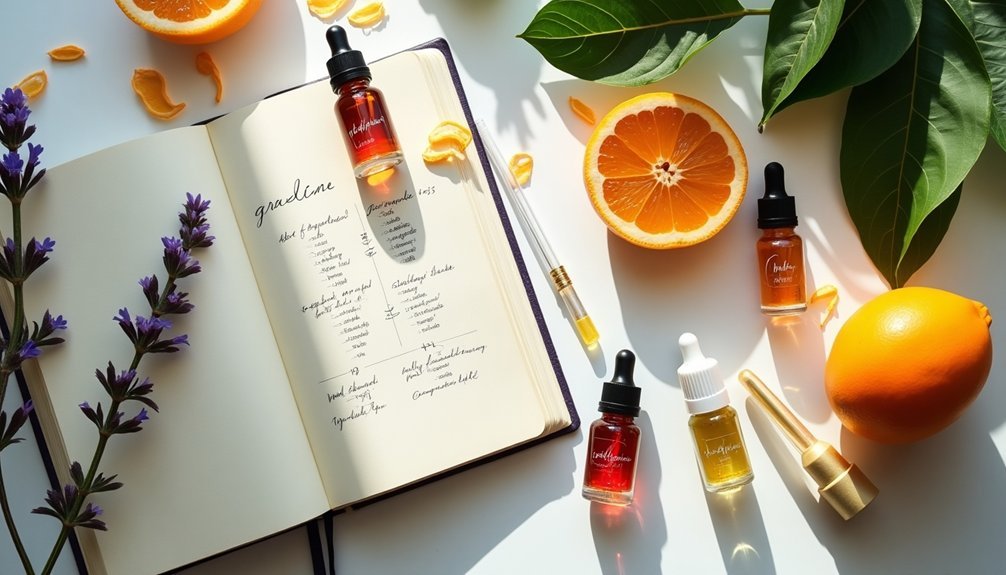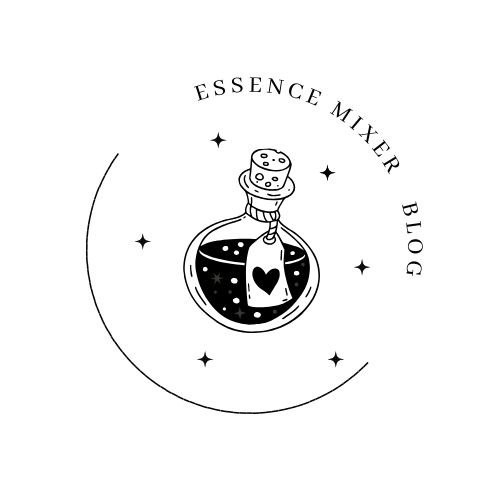You'll find that floral scents mix beautifully with citrus notes, while woody fragrances enhance both floral and spicy combinations. Start by following the 30-50-20 ratio of top, middle, and base notes for balanced blends. Test your combinations on blotter strips first, then apply stronger scents to pulse points and lighter ones on clothing. Let mixed fragrances settle for 30 minutes before evaluating. Mastering these basics opens the door to endless signature scent possibilities.
Understanding Basic Fragrance Families and Their Affinities

When exploring fragrance combinations, understanding the main scent families is essential for creating harmonious blends. The key fragrance families include Floral, Oriental, Woody, Fresh/Citrus, and Gourmande, each offering unique characteristics and combination possibilities.
Floral scents, like the iconic Chanel No. 5, work beautifully with citrus notes to create vibrant, fresh compositions.
Floral fragrances shine brightest when paired with zesty citrus notes, creating an energetic and refreshing aromatic symphony.
When you're combining fragrances, you'll find that woody fragrances, such as Gucci Guilty for Men, enhance both floral and spicy notes.
Oriental scents like Tom Ford Black Orchid become even more luxurious when paired with vanilla or woody undertones.
If you're working with fresh and citrus-based perfumes like Acqua di Gio, you'll discover they blend perfectly with woody or fougere notes for an invigorating result.
Essential Oil Blending Ratios and Proportions
Three fundamental ratios guide successful essential oil blending: 30% top notes, 50% middle notes, and 20% base notes.
When you're starting your fragrance combination journey, begin with just one or two drops of each oil to maintain control over your blend's development.
For beginners, try using equal parts (1:1:1) of your chosen oils to create simple yet effective blending proportions. If you're seeking a more intense fragrance, increase your base notes to 20-30% of the total mixture. This adjustment will create a deeper, longer-lasting scent profile.
Remember to let your blended fragrance notes rest for at least 24 hours before making any final assessments. This waiting period is essential as it allows the oils to meld together, often resulting in a notably different and more harmonious scent.
Top Note and Base Note Compatibility Charts

Building on your understanding of blending ratios, a well-organized compatibility chart can streamline your fragrance creation process.
When exploring scent combinations, you'll find that citrus top notes pair exceptionally well with green or herbal base notes, creating an invigorating contrast that enhances the overall freshness of your blend.
For successful fragrance layering, consider matching floral top notes like jasmine or rose with woody base notes such as sandalwood or patchouli. This creates a balanced, harmonious profile that flows smoothly from initial impression to lasting finish.
You'll achieve the best results by pairing fresh, citrusy top notes with warm, comforting base notes like vanilla or cedarwood. These complementary combinations guarantee your fragrance maintains both immediate appeal and lasting depth throughout its wear time.
The Science Behind Scent Layering Success
The intricate science of fragrance layering relies heavily on understanding molecular interactions and evaporation rates. When you're combining scents, you'll need to take into account how different fragrance families interact and evolve over time.
Top notes dissipate quickly, while base notes provide lasting depth to your layered combination.
Your personal preferences and body chemistry greatly influence how fragrances develop on your skin. What works for others mightn't work for you, as individual biology affects how scents interact and mature.
To achieve the best layering results, start with a warm base fragrance and gradually add lighter, complementary notes. Always test your combinations on clean skin and wait 30 minutes to observe how the scents develop.
This patient approach helps you discover which fragrances truly harmonize with each other.
Testing Methods for Fragrance Combinations

Once you understand the science behind fragrance layering, you'll need practical methods to test your combinations. Start by experimenting with blotter strips, which let you safely explore different pairings without committing them to your skin.
Test fragrance combinations safely on blotter strips first – it's the smartest way to discover your perfect scent pairings.
When you've found complementary fragrances that intrigue you, apply the stronger scent directly to your skin while lightly spritzing the softer fragrance in a separate area.
Consider layering different types of notes, such as combining warm base scents with bright, airy fragrances. Give your combination about 30 minutes to develop – this waiting period reveals how the scents interact and evolve together.
Remember that personal preference guides your choices, so don't shy away from unexpected pairings. The perfect blend often comes from trusting your instincts while following these testing methods.
Natural Versus Synthetic Ingredient Pairings
Understanding how natural and synthetic ingredients interact can revolutionize your fragrance combinations.
You'll find that natural ingredients from plants and flowers create subtle, complex profiles that can beautifully complement the lasting power of synthetic ingredients. When you're blending fragrance families, consider pairing essential oils with synthetic compounds to achieve both depth and vibrancy.
Try combining natural vanilla or jasmine with synthetic musks to create unique scents that are both warm and enduring.
Keep in mind that natural ingredients tend to evaporate more quickly, so you'll want to balance them with synthetic components for longer-lasting wear.
You'll also discover that synthetic ingredients can recreate rare natural scents, expanding your creative possibilities.
This harmonious blend of nature and science offers endless opportunities for crafting distinctive fragrance combinations.
Seasonal Fragrance Mixing Guidelines
You'll discover that seasonal fragrance mixing requires thoughtful consideration of each season's unique characteristics, from breezy aquatic-woody combinations in summer to rich oud-gourmand pairings in winter.
For spring and fall changes, you can blend floral-citrus notes or combine spicy-oriental scents with vanilla undertones, respectively.
When creating your seasonal fragrance mix, follow nature's lead by choosing lighter, fresher scents for warmer months and warmer, deeper notes for cooler seasons.
Summer Fresh Scent Pairings
When summer temperatures rise, mixing the right fragrances can create a revitalizing and vibrant scent experience.
You'll find that fresh scents from different fragrance families blend perfectly for the season. Try combining citrus notes like bergamot or lemon with jasmine or peony for an uplifting summer blend.
To capture ocean breezes, pair woody fragrances like cedar with aquatic notes.
You can also layer fruity notes to create sweet summer combinations – try peach or raspberry with your favorite florals.
For a clean, energizing effect, mix ozonic scents with citrus fragrances.
When mixing perfumes for summer, opt for lighter concentrations since they evaporate quickly in warm weather.
This approach guarantees your fragrance remains invigorating without becoming overwhelming in the heat.
Winter Warming Fragrance Combinations
During winter's chilly embrace, the art of mixing fragrances shifts toward creating warm, enveloping combinations that comfort and cocoon. You'll find success pairing warm and comforting scents like amber and vanilla with rich spices such as cinnamon or clove. These combinations create a perfect winter atmosphere that feels both festive and inviting.
Try layering woody notes like cedarwood with deep florals such as jasmine for sophisticated depth.
For an extra cozy touch, incorporate gourmand scents by combining chocolate or caramel notes with warming spices. If you're worried about your blend becoming too heavy, add a splash of citrus – bergamot or grapefruit work wonderfully to brighten and balance these deeper winter fragrances while maintaining their comforting essence.
Spring-Fall Transitional Blends
As the seasons shift between spring and fall, mastering changeable fragrance blends requires a delicate balance of fresh and warm notes.
You'll find success by combining floral notes with woody or spicy notes to create spring-fall interchange blends that adapt to temperature fluctuations.
Start with citrus-based fragrances like bergamot or lemon, then pair them with earthy vetiver or sandalwood for depth while maintaining brightness.
Try layering a light floral scent with vanilla or amber to achieve both comfort and uplift.
For more complexity, use single-note fragrances like fresh rose as your base, then build depth by adding oud or patchouli.
You can also experiment with fresh green notes alongside gourmand scents to capture the essence of seasonal interchange, creating versatile combinations that work beautifully during both spring and fall.
Creating Depth Through Complementary Notes
Since fragrance layering is an art of balance, creating depth requires a thoughtful combination of complementary notes that work in harmony. To create a scent with dimension, start by pairing scents from different notes that enhance each other naturally.
| Base Note | Complementary Top Note |
|---|---|
| Vanilla | Citrus |
| Amber | Floral |
| Wood | Rose |
| Oriental | Gourmand |
When working with fragrance family combinations, you'll find that woody notes perfectly balance floral sweetness, while oriental bases gain complexity when paired with gourmand elements. For best results, apply stronger fragrances to your pulse points and lighter scents to your clothing. This layering technique allows the scent to evolve throughout the day, creating a sophisticated and personalized aromatic experience that's uniquely yours.
Troubleshooting Common Mixing Mistakes
When mixing fragrances, you'll need to watch for potential scent clashes by sticking to compatible fragrance families rather than combining contrasting ones like heavy orientals with light citrus notes.
You can prevent overwhelming combinations by applying stronger scents sparingly on pulse points while reserving lighter fragrances for clothing and hair.
To achieve the right balance, let your mixed scents settle for 30 minutes, allowing you to assess their true harmony and make adjustments to the intensity as needed.
Avoiding Scent Clashes
Despite the creative possibilities of mixing fragrances, avoiding scent clashes requires careful attention to prevent common mistakes. You'll want to avoid combining similar fragrance families, as they can create an overwhelming effect. When layering fragrances together, start with a warm base and add lighter, contrasting scents to create depth in your perfume combination.
| Do This | Don't Do This |
|---|---|
| Allow 30 minutes for scents to mature | Rush to judge the combination |
| Use discovery sets for testing | Mix multiple similar scents |
| Layer strong scents sparingly | Overpower with dominant fragrances |
| Choose contrasting fragrances | Combine competing base notes |
| Start with a warm base | Mix without a foundation |
To find complementary combinations, test your fragrances on your skin and give them time to develop their full character before making a final judgment.
Balancing Fragrance Intensity
Mastering fragrance intensity requires understanding the delicate balance between strong and light scents. When creating your signature scent through layering, start with lighter fragrances and gradually add stronger ones to prevent overwhelming combinations.
To achieve the perfect balance, apply stronger scents sparingly to your pulse points while using lighter fragrances more liberally across your skin. Pay attention to how scents interact by testing your combination and letting it settle for about 30 minutes.
You'll want to choose fragrances with similar concentrations to maintain harmony and prevent one scent from dominating.
For the best results, consider combining scents from the same fragrance family, as they naturally complement each other. If you're mixing different families, carefully evaluate each scent's intensity to create a well-balanced blend that evolves beautifully on your skin.
Frequently Asked Questions
What Fragrances Layer Well Together?
You'll find that floral scents blend beautifully with citrus notes, while woody fragrances pair well with spicy aromas. Try combining oriental scents with vanilla, or layer warm base notes with bright florals.
What Scents Go Well Together?
You'll find floral notes blend beautifully with citrus, while woody scents complement spicy or oriental fragrances. Fruity and gourmand notes pair well together, and aquatic scents work great with fresh, citrus combinations.
Can You Mix Two Fragrances Together?
Yes, you can mix fragrances together! Start with complementary scents from similar families, like floral with woody notes. Test small amounts first, and let them settle for 30 minutes to experience the full blend.
What to Layer With Sandalwood?
You'll find sandalwood blends beautifully with jasmine and rose for warmth, citrus notes for brightness, amber or oud for depth, vanilla for sweetness, and spices like cinnamon for complexity in your fragrance combinations.
In Summary
You've now got the essential tools to create beautiful fragrance combinations with confidence. Remember to start with the basic families, use proper ratios, and test your blends before committing. Don't be afraid to experiment, but always document your successes and failures. Whether you're working with natural or synthetic scents, you'll find that mastering fragrance mixing is both an art and a science.





Leave a Reply